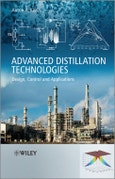Advanced Distillation Technologies: Design, Control and Applications gives a deep and broad insight into integrated separations using non-conventional arrangements, including both current and upcoming process intensification technologies.
It includes:
- Key concepts in distillation technology - Principles of design, control, sizing and economics of distillation - Dividing-wall column (DWC) – design, configurations, optimal operation and energy efficient and advanced control - DWC applications in ternary separations, azeotropic, extractive and reactive distillation - Heat integrated distillation column (HIDiC) – design, equipment and configurations - Heat-pump assisted applications (MVR, TVR, AHP, CHRP, TAHP and others) - Cyclic distillation technology – concepts, modeling approach, design and control issues - Reactive distillation – fundamentals, equipment, applications, feasibility scheme - Results of rigorous simulations in Mathworks Matlab & Simulink, Aspen Plus, Dynamics and Custom Modeler
Containing abundant examples and industrial case studies, this is a unique resource that tackles the most advanced distillation technologies – all the way from the conceptual design to practical implementation.
The author of Advanced Distillation Technologies, Dr. Ir. Anton A. Kiss, has been awarded the Hoogewerff Jongerenprijs 2013.
Table of Contents
Preface xiiiAcknowledgements xv
1 Basic Concepts in Distillation 1
1.1 Introduction 1
1.2 Physical Property Methods 2
1.3 Vapor Pressure 6
1.4 Vapor–Liquid Equilibrium and VLE Non-ideality 8
1.5 Relative Volatility 13
1.6 Bubble Point Calculations 14
1.7 Ternary Diagrams and Residue Curve Maps 16
1.8 Analysis of Distillation Columns 24
1.9 Concluding Remarks 34
References 35
2 Design, Control and Economics of Distillation 37
2.1 Introduction 37
2.2 Design Principles 38
2.3 Basics of Distillation Control 44
2.4 Economic Evaluation 55
2.5 Concluding Remarks 63
References 64
3 Dividing-Wall Column 67
3.1 Introduction 67
3.2 DWC Configurations 70
3.3 Design of DWCs 75
3.4 Modeling of a DWC 83
3.5 DWC Equipment 87
3.6 Case Study: Separation of Aromatics 97
3.7 Concluding Remarks 103
References 107
4 Optimal Operation and Control of DWC 111
4.1 Introduction 111
4.2 Degrees of Freedom Analysis 112
4.3 Optimal Operation and Vmin Diagram 114
4.4 Overview of DWC Control Structures 117
4.5 Control Guidelines and Rules 128
4.6 Case Study: Pentane–Hexane–Heptane Separation 129
4.7 Case Study: Energy Efficient Control of a BTX DWC 132
4.8 Concluding Remarks 148
References 149
5 Advanced Control Strategies for DWC 153
5.1 Introduction 153
5.2 Overview of Previous Work 154
5.3 Dynamic Model of a DWC 156
5.4 Conventional versus Advanced Control Strategies 163
5.5 Energy Efficient Control Strategies 171
5.6 Concluding Remarks 180
Notation 181
References 183
6 Applications of Dividing-Wall Columns 187
6.1 Introduction 187
6.2 Separation of Ternary and Multicomponent Mixtures 188
6.3 Reactive Dividing-Wall Column 195
6.4 Azeotropic Dividing-Wall Column 198
6.5 Extractive Dividing-Wall Column 199
6.6 Revamping of Conventional Columns to DWC 203
6.7 Case Study: Dimethyl Ether Synthesis by R-DWC 205
6.8 Case Study: Bioethanol Dehydration by A-DWC and E-DWC 212
6.9 Concluding Remarks 223
References 223
7 Heat Pump Assisted Distillation 229
7.1 Introduction 229
7.2 Working Principle 231
7.3 Vapor (Re)compression 232
7.4 Absorption–Resorption Heat Pumps 234
7.5 Thermo-acoustic Heat Pump 236
7.6 Other Heat Pumps 240
7.7 Heat-Integrated Distillation Column 244
7.8 Technology Selection Scheme 245
7.9 Concluding Remarks 265
References 265
8 Heat-Integrated Distillation Column 271
8.1 Introduction 271
8.2 Working Principle 273
8.3 Thermodynamic Analysis 277
8.4 Potential Energy Savings 280
8.5 Design and Construction Options 282
8.6 Modeling and Simulation 295
8.7 Process Dynamics, Control, and Operation 297
8.8 Applications of HIDiC 300
8.9 Concluding Remarks 304
References 305
9 Cyclic Distillation 311
9.1 Introduction 311
9.2 Overview of Cyclic Distillation Processes 313
9.3 Process Description 316
9.4 Mathematical and Hydrodynamic Model 319
9.5 Modeling and Design of Cyclic Distillation 327
9.6 Control of Cyclic Distillation 335
9.7 Cyclic Distillation Case Studies 338
9.8 Concluding Remarks 347
References 349
10 Reactive Distillation 353
10.1 Introduction 353
10.2 Principles of Reactive Distillation 354
10.3 Design, Control and Applications 357
10.4 Modeling Reactive Distillation 362
10.5 Feasibility and Technical Evaluation 364
10.6 Case Study: Advanced Control of a Reactive Distillation Column 371
10.7 Case Study: Biodiesel Production by Heat-Integrated RD 378
10.8 Case Study: Fatty Esters Synthesis by Dual RD 383
10.9 Concluding Remarks 387
References 388
Index 393








